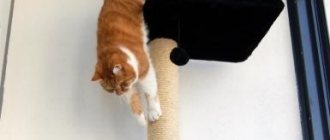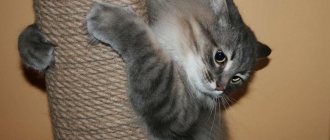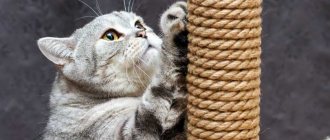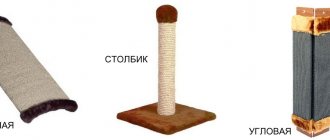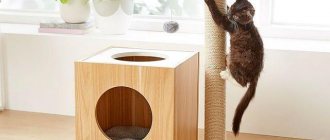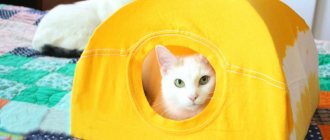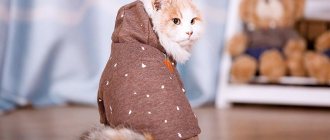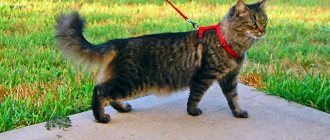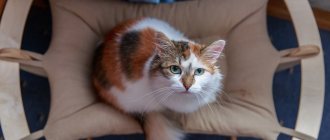A kitten in the house is always a source of joy and positivity, but it is important not to forget that the pet has its own needs. For example, a timely purchased scratching post will not only save furniture and wall coverings from sharp cat claws, but will also certainly please the kitten. In addition, do not forget that you can easily make a device from wood and strong rope yourself.
Making a scratching post
In specialized stores for animals you can find a wide variety of designs for sharpening claws - overhead, corner, in the form of labyrinths or simple columns. But a self-made scratching post has a number of advantages:
- Save money, since a hand-made design will cost several times less than one purchased in a store.
- For manufacturing and decoration, you can take any materials, taking into account what will fit into your interior.
- If you try, you can construct an entire play complex with a variety of columns, shelves and transitions. Such labyrinths are quite difficult to find in the store.
- The design details can be adjusted to the size of the pet. What is presented in specialized stores is produced according to standard sizes and does not always fit the size and age of the animal.
In order to make a regular scratching post, you only need two things - a post and a rope. We'll talk about what rope to use for the scratching post a little later.
Requirements for a homemade design
Store-bought copies often do not shine with practicality. The main drawback of many models is instability. Therefore, the first important criterion for a DIY scratching post is its reliability. The design must also:
- not too bulky, which is especially necessary for small apartments;
- be durable - very durable, made of high-quality materials;
- have a nice appearance, since it will not be the last element of the interior.
Some purchased scratching posts may meet these requirements, but these models are a direct path to emptying your wallet. Their other drawback is synthetic materials, the “aroma” of which delicate cat noses are not able to get used to.
The naturalness of all materials is another mandatory condition if the owners want the pet not to reject what was done with backbreaking labor. You need to use wood, natural materials, cardboard packaging, burlap, twine.
Types of scratching posts
What kind of scratching post you get as a result depends only on your desire, skills and the amount of time spent on its manufacture. To make the simplest standard structure in the form of a column covered with rope, it will take a maximum of an hour. If you decide to put together an interesting gaming complex for one or several pets, then you will have to work hard and allocate much more time for this.
The simplest version of the play complex consists of several posts and a shelf fixed on top where the pet can rest. The remaining details depend only on your imagination.
How much rope will be needed?
Any modern rope for a scratching post has a high degree of strength and is resistant to tearing, which makes it an ideal material in this case. Before proceeding with the manufacture or replacement of this element, it is necessary to calculate the length that will be required.
There are two ways to measure footage:
- Using old rope for a scratching post. In this case, you need to remove the rope from the old post, measure its length, or take the rope with you to the store so that the consultant can help you choose the material and footage.
- Calculation using a special formula:
Rope length = (post height/rope diameter) * 3.14 * post diameter.
For example, there is the following data:
- The height of the column is 100 cm, its diameter is 10 cm;
- Rope diameter – 0.8 cm.
From here we get: rope length = (100/0.8) * 3.14 * 10 = 3925 cm, that is, 39.25 m.
The optimal rope diameter is considered to be 8 mm, but 6 mm is quite suitable for making a scratching post.
Detailed job description
List of necessary materials for the kitty corner:
- rectangle made of fiberboard (40*122 cm);
- rectangle made of chipboard (44*61 cm);
- 2 rectangles made of chipboard (55*44 cm);
- rectangle made of chipboard (44*30 cm);
- wooden slats - 7 pieces (3*4*37 cm);
- pipe with a diameter of 110 cm, length 60 cm;
- 2 wooden blocks;
- rope diameter 11 mm, 15 meters in length;
- thin fabric or rope for an inclined climbing frame;
- self-tapping screws;
- 2 pieces of rectangular foam rubber (44*30 and 33*36 cm);
- heat gun;
- faux fur (2 square meters);
- toys;
- jigsaw;
- saw;
- screwdriver;
- drill;
- compass;
- stapler for furniture;
- roulette;
- sharp scissors;
- sandpaper;
- pencils or chalk.
First you need to cut out rectangles of the required size from fiberboard and chipboard. In the rectangles that are set aside from the wall, make truncated circles with a radius of 26 cm. To do this, draw a figure with a compass, which will then be cut out. It is best to make drawings on paper in advance.
We only need one circle. To enter the house on the right, make a circle. Dimensions: 21 cm in diameter.
Then draw three circles, each with a diameter of 5 cm, to create an imitation of a cat’s paws, as in the photo:
Next, make all the holes with a jigsaw, place the circles one on top of the other, mark seven points on one and the second wall.
Now you need to drill holes in two walls using a thin drill, or screw in a self-tapping screw and unscrew it. Then drill small holes for self-tapping screws on both walls at the attachment points. Saw off seven slats with a rectangular cross-section. Fasten the walls with screws and slats.
Which rope is better to choose?
The choice of ropes is very large, but the main thing you need to pay attention to when choosing is natural fibers. Environmentally friendly materials of natural origin are the best ropes for scratching posts; they are completely safe for both animals and people, are not electrified and will not harm the pet. A cat will definitely like a scratching post coated with natural fiber, which cannot be said about a purchased one made from artificial rope. Some pets may be put off by the synthetic smell, as well as the presence of paint and impregnation.
Polypropylene and nylon ropes are several times stronger than natural ones, but they tend to stretch, and cat's claws can get tangled and stuck in the fibers of the material.
A hemp rope wrap for a scratching post will not last long; the material will quickly fluff due to fragments of fibers.
Anti-vandal fabrics
Modern manufacturers meet the wishes of pet owners and produce special materials that can be used to protect upholstered furniture from the sharp claws of a pet. Scope of application of anti-vandal fabrics:
- as furniture upholstery materials;
- for removable covers;
- when making a sleeping place for a pet.
What to sew a cat bed from or make an unusual homemade ottoman? We list several of the most popular options for anti-claw fabrics:
- Flock. This two-layer fabric is combined from natural and polymer fibers and impregnated with a special compound that increases strength and resistance to wetness. The outer fibers have a long-lasting color and are resistant to stains. To remove dirt, simply wipe the flock with a damp cloth. For long-term use, the fabric can be washed in a washing machine. The fabric surface is smooth, so cat claws cannot catch and pull out the fibers. It is recommended to vacuum this material frequently, since flock is easily electrified (like any synthetics) and attracts dust.
- Relax is a combined synthetic fabric in which a base of cotton and polyester is covered with a layer of isoprene. Thanks to this composition, the fabric invariably retains a neat and elegant appearance and lasts for many years, requiring virtually no maintenance. Elastic material cannot be scratched. Dirt from the surface of the relaxation area can be easily removed with soapy water.
- Faux suede consists of two layers. The base is a mixed fabric made of cotton and polyamide, and the top fleecy layer is polyester. The advantage of this material is the absence of electrification and permeability to air. Wet cleaning and washing are not permitted. In case of severe contamination, you will have to invite specialists in chemical cleaning of furniture. Unfortunately, faux suede is not very durable, so a diligent cat can tear this fabric.
- Microfiber is a synthetic fabric formed by interweaving thin artificial threads. Typically, manufacturers impregnate the fabric with Teflon, which makes the material tear-resistant. This durable material is easy to care for: it can be machine washed and wet cleaned with a wet sponge.
- Tapestry fabric is a dense material formed by the interweaving of thick threads. The tapestry looks stylish and expensive. The only drawback is that the tapestry is afraid of ultraviolet radiation and easily loses its original shade in direct sunlight.
- Scotchgard is a jacquard weave fabric with water-repellent impregnation. This canvas is well protected from damage and always retains its original bright pattern. Allows dry cleaning, wiping with soapy water or a special cleaning agent.
The play complex was made by ourselves for kittens
Cattery kittens on a homemade three-story scratching post complex with beds, a house, and a hammock
Types of ropes
The question of what cat scratching posts are made of worries many owners who have decided to please their pet. There are several of the most common types of rope for a scratching post that can be used to wrap a post:
- Cotton rope. This material looks great and fits perfectly into any interior, but is much more expensive than other types.
- Sisal rope. Its cost is much lower, the structure is fleecy, the material is quite strong, durable with a grayish or pale yellow tint.
- Jute rope. This material is most often used in scratching posts that are sold in stores. Jute rope for scratching posts is the cheapest, but has less strength compared to previous materials.
All these materials differ radically from each other in a number of basic parameters, which primarily determine how long the scratching post will last. Therefore, next we will look at what ropes for scratching posts are called and compare their types to make it easier to systematize the information for the right choice.
Toy out of the box for intelligence development
Interactive toys and labyrinths are very popular among cat owners, which not only captivate their pets, but also help develop their intelligence. Such devices are not cheap, so many people create them with their own hands.
Your pet will definitely love this homemade puzzle made from a cardboard box. Several holes are made in the body from different sides. Holes of equal size are also cut out on the lid of the box. They should not be too large so that only the pet’s paws fit through them.
To prevent the box from quickly losing its shape, it is taped around the entire perimeter. Place any round objects inside that easily roll when the cat touches them with his paw.
Another popular educational toy idea is a tunnel house. It is also made from a box, but larger in size. The pet should freely enter the tunnel through the holes on the sides. To attract the cat's attention, colorful ribbons are attached to the box, and fragrant treats, balls, and rustling toys are placed in the house.
What to choose - jute or sisal fiber?
So, both types are popular due to their affordable cost. This factor is quite significant, because winding a post requires several tens of meters of rope. But you should immediately pay special attention to the fact that no matter what material you choose, the scratching post will not last forever! Any thing wears out over time, and this product is no exception. The lifespan of the scratching post depends on the following parameters:
- How often does the pet use it?
- Breed of the animal (large representatives have a much larger nail plate).
- The quality of the scratching post.
Jute is made from the plant of the same name in the mallow family. Its fibers are mainly used in the textile industry, as well as for making ropes and burlap. Features of jute:
- Gray-brown fiber color.
- Softness.
- Smoothness (fibers do not stick out).
- Low cost compared to similar materials.
Sisal rope is much coarser than jute because it is made from raw fibers obtained from the leaves of the agave tree. This plant has unique qualities, which allows it to be used in a wide variety of industries, from food to construction. What features does sisal have?
- Quite a rigid structure.
- Light sandy shade.
- High wear resistance.
Hemp for scratching post
If you just can’t choose or for some reason don’t want to purchase sisal and jute rope, then you can consider another option for wrapping the scratching post - hemp threads. This material is made from hemp plants, which do not contain narcotic substances. The fibers are used in the production of fabrics and ropes. Although jute and sisal ropes are favored by pet product manufacturers, hemp is just as good, proving that hemp remains an important resource in the industry. New fibers are also mistakenly called hemp - sisal, jute and others. So, let's look at the advantages of hemp threads:
- A variety of colors (the shade can be absolutely any, depending on the processing method).
- Has an average price.
- Its properties are superior to jute rope.
- High strength.
- Resistance to environmental influences.
- High hygroscopic and anti-electrostatic properties.
